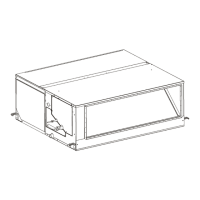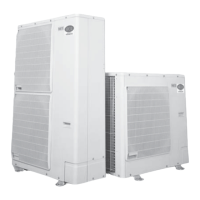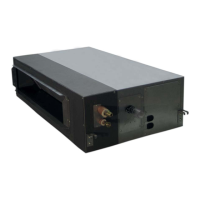Do you have a question about the Hitachi RPI-5.0FSN4E and is the answer not in the manual?
Information regarding reproduction, changes, and printing errors in the publication.
Guide to product identification, model classification, and special model information.
Instructions to check model name, system type, and included manuals before installation.
Details on classifying outdoor unit models based on type, capacity, refrigerant, and special features.
Describes power range and combination options for FSXN1E outdoor units.
Describes power range and combination options for FSXNH outdoor units.
Explains the meaning of symbols used throughout the manual for safety and notes.
Provides essential safety precautions, including DANGER and CAUTION notices for unit operation and handling.
Details safety devices and warnings related to the high-pressure vessel and switch in the refrigerant system.
Details the automatic functions of the system, such as compressor protection, frost prevention, and hot start.
Identifies and labels the components of the RAS-8FSXN1E outdoor unit with a detailed parts list.
Identifies and labels the components of the RAS-(10/12)FSXN1E outdoor unit with a detailed parts list.
Identifies and labels the components of the RAS-(14/16)FSXN1E outdoor unit with a detailed parts list.
Identifies and labels the components of the RAS-(5/6)FSXNH(E) outdoor unit with a detailed parts list.
Identifies and labels the components of the RAS-(8-12)FSXNH(E) outdoor unit with a detailed parts list.
Illustrates the refrigerant cycle and lists components for RAS-(8-12)FSXN1E models.
Illustrates the refrigerant cycle and lists components for RAS-(14/16)FSXN1E models.
Illustrates the refrigerant cycle and lists components for RAS-(5/6)FSXNH(E) models.
Illustrates the refrigerant cycle and lists components for RAS-(8-12)FSXNH(E) models.
Provides instructions for safely transporting outdoor units, including fastening and storage.
Details safe handling procedures for outdoor units using fork-lift trucks to prevent injury and damage.
Explains the correct method for lifting outdoor units using slings, emphasizing safety precautions.
Lists the center of gravity dimensions for various outdoor unit models for lifting and installation.
Outlines essential conditions for outdoor unit placement, considering sunlight, noise, ventilation, and access.
Specifies the required clearance and space around the outdoor unit for installation and servicing.
Provides guidelines for installing units based on surrounding wall configurations.
Provides installation space guidelines for units installed with walls in two directions.
Provides installation space guidelines for units installed with walls in three directions.
Provides installation space guidelines for units installed with walls in four directions.
Discusses factors affecting installation space, air flow, and unit grouping.
Details requirements for foundation and anchorage of outdoor units.
Details requirements for outdoor unit foundations, including height, drainage, and strength.
Specifies the correct placement and securing of anchorage bolts for outdoor unit installation.
Guides on selecting appropriate refrigerant pipe sizes based on system type and outdoor unit power.
Guides on selecting appropriate refrigerant pipe sizes based on system type and outdoor unit power.
Provides specifications for copper pipes, including diameters, thicknesses, and insulation requirements.
Details the pipe connection kits available for FSXN1E series, including diagrams.
Provides pipe size specifications for SET FREE FSXN1E series using 3-pipe configurations.
Continues providing pipe size specifications for SET FREE FSXN1E series with 3-pipe configurations.
Offers precautions for installing outdoor units, especially regarding unit order and pipe placement.
Provides general instructions for installing refrigerant pipes, including material, diameter, and connections.
Details the procedure for mounting flared connections, including torque specifications and cautions.
Explains the importance and method of insulating refrigerant pipes to prevent temperature loss and condensation.
Illustrates pipe connection methods for heat pump (2-pipe) and heat recovery (3-pipe) systems.
Specifies permitted pipe lengths and height differences for heat pump systems (2 pipes).
Specifies permitted pipe lengths and height differences for heat recovery systems (3 pipes).
Details the procedure for performing an air-tight test on the refrigerant system, including valve checks and pressure.
Explains how to calculate the additional refrigerant needed based on piping length and unit capacity.
Describes the process of charging the system with additional refrigerant after vacuuming and system checks.
Provides specific warnings and torque values for opening stop valves to prevent refrigerant leakage or damage.
Details the system for automatically judging the refrigerant amount and identifying potential issues.
Highlights critical gas concentration limits and necessary actions to prevent refrigerant gas leakage.
Advises on safety measures, concentration limits, and calculations related to refrigerant leaks.
States the maximum permissible concentration of HFC R410A gas in the air to ensure safety.
Explains the importance of proper drainage for condensation and precautions related to drainage systems.
Details the condensation drainage system requirements and the use of optional drainage kits.
General safety precautions and guidelines for performing electrical wiring work on the units.
Lists necessary checks for electrical components, supply voltage, and wiring before installation.
Specifies recommended wire sizes for power source and transmission cables based on unit specifications.
Details electrical data and recommended breaker sizes for individual outdoor units.
Covers voltage requirements, including service, start-up, imbalance, and impedance limits.
Outlines system impedance requirements for electromagnetic compatibility according to EN61000-3-11.
Addresses compliance with IEC standards for harmonics and short-circuit current (Ssc).
Provides instructions for connecting electrical wiring to outdoor unit terminal boards.
Explains how to connect indoor units, CH units, and outdoor units via communication cables.
Details how to set external input/output functions and select operating modes using PCB switches.
Lists essential checks before performing the test run, including wiring, refrigerant pipes, and system settings.
Provides a step-by-step guide for conducting the test run on the installed system, including sequence and checks.
Explains how to use the PC-ART remote controller to enter and operate the test run mode.
Details how to use the PC-ARF remote controller for test run operations, including setting and checks.
A checklist to verify correct operation during the test run, covering fans, compressor, temperatures, and pressures.
Lists common alarm codes, categories, content, and possible causes for troubleshooting system issues.
Describes the devices and combinations that protect the compressor from damage due to pressure or oil issues.
Information regarding reproduction, changes, and printing errors in the publication.
Guide to product identification, model classification, and special model information.
Instructions to check model name, system type, and included manuals before installation.
Details on classifying outdoor unit models based on type, capacity, refrigerant, and special features.
Describes power range and combination options for FSXN1E outdoor units.
Describes power range and combination options for FSXNH outdoor units.
Explains the meaning of symbols used throughout the manual for safety and notes.
Provides essential safety precautions, including DANGER and CAUTION notices for unit operation and handling.
Details safety devices and warnings related to the high-pressure vessel and switch in the refrigerant system.
Details the automatic functions of the system, such as compressor protection, frost prevention, and hot start.
Identifies and labels the components of the RAS-8FSXN1E outdoor unit with a detailed parts list.
Identifies and labels the components of the RAS-(10/12)FSXN1E outdoor unit with a detailed parts list.
Identifies and labels the components of the RAS-(14/16)FSXN1E outdoor unit with a detailed parts list.
Identifies and labels the components of the RAS-(5/6)FSXNH(E) outdoor unit with a detailed parts list.
Identifies and labels the components of the RAS-(8-12)FSXNH(E) outdoor unit with a detailed parts list.
Illustrates the refrigerant cycle and lists components for RAS-(8-12)FSXN1E models.
Illustrates the refrigerant cycle and lists components for RAS-(14/16)FSXN1E models.
Illustrates the refrigerant cycle and lists components for RAS-(5/6)FSXNH(E) models.
Illustrates the refrigerant cycle and lists components for RAS-(8-12)FSXNH(E) models.
Provides instructions for safely transporting outdoor units, including fastening and storage.
Details safe handling procedures for outdoor units using fork-lift trucks to prevent injury and damage.
Explains the correct method for lifting outdoor units using slings, emphasizing safety precautions.
Lists the center of gravity dimensions for various outdoor unit models for lifting and installation.
Outlines essential conditions for outdoor unit placement, considering sunlight, noise, ventilation, and access.
Specifies the required clearance and space around the outdoor unit for installation and servicing.
Provides guidelines for installing units based on surrounding wall configurations.
Provides installation space guidelines for units installed with walls in two directions.
Provides installation space guidelines for units installed with walls in three directions.
Provides installation space guidelines for units installed with walls in four directions.
Discusses factors affecting installation space, air flow, and unit grouping.
Details requirements for foundation and anchorage of outdoor units.
Details requirements for outdoor unit foundations, including height, drainage, and strength.
Specifies the correct placement and securing of anchorage bolts for outdoor unit installation.
Guides on selecting appropriate refrigerant pipe sizes based on system type and outdoor unit power.
Guides on selecting appropriate refrigerant pipe sizes based on system type and outdoor unit power.
Provides specifications for copper pipes, including diameters, thicknesses, and insulation requirements.
Details the pipe connection kits available for FSXN1E series, including diagrams.
Provides pipe size specifications for SET FREE FSXN1E series using 3-pipe configurations.
Continues providing pipe size specifications for SET FREE FSXN1E series with 3-pipe configurations.
Offers precautions for installing outdoor units, especially regarding unit order and pipe placement.
Provides general instructions for installing refrigerant pipes, including material, diameter, and connections.
Details the procedure for mounting flared connections, including torque specifications and cautions.
Explains the importance and method of insulating refrigerant pipes to prevent temperature loss and condensation.
Illustrates pipe connection methods for heat pump (2-pipe) and heat recovery (3-pipe) systems.
Specifies permitted pipe lengths and height differences for heat pump systems (2 pipes).
Specifies permitted pipe lengths and height differences for heat recovery systems (3 pipes).
Details the procedure for performing an air-tight test on the refrigerant system, including valve checks and pressure.
Explains how to calculate the additional refrigerant needed based on piping length and unit capacity.
Describes the process of charging the system with additional refrigerant after vacuuming and system checks.
Provides specific warnings and torque values for opening stop valves to prevent refrigerant leakage or damage.
Details the system for automatically judging the refrigerant amount and identifying potential issues.
Highlights critical gas concentration limits and necessary actions to prevent refrigerant gas leakage.
Advises on safety measures, concentration limits, and calculations related to refrigerant leaks.
States the maximum permissible concentration of HFC R410A gas in the air to ensure safety.
Explains the importance of proper drainage for condensation and precautions related to drainage systems.
Details the condensation drainage system requirements and the use of optional drainage kits.
General safety precautions and guidelines for performing electrical wiring work on the units.
Lists necessary checks for electrical components, supply voltage, and wiring before installation.
Specifies recommended wire sizes for power source and transmission cables based on unit specifications.
Details electrical data and recommended breaker sizes for individual outdoor units.
Covers voltage requirements, including service, start-up, imbalance, and impedance limits.
Outlines system impedance requirements for electromagnetic compatibility according to EN61000-3-11.
Addresses compliance with IEC standards for harmonics and short-circuit current (Ssc).
Provides instructions for connecting electrical wiring to outdoor unit terminal boards.
Explains how to connect indoor units, CH units, and outdoor units via communication cables.
Details how to set external input/output functions and select operating modes using PCB switches.
Lists essential checks before performing the test run, including wiring, refrigerant pipes, and system settings.
Provides a step-by-step guide for conducting the test run on the installed system, including sequence and checks.
Explains how to use the PC-ART remote controller to enter and operate the test run mode.
Details how to use the PC-ARF remote controller for test run operations, including setting and checks.
A checklist to verify correct operation during the test run, covering fans, compressor, temperatures, and pressures.
Lists common alarm codes, categories, content, and possible causes for troubleshooting system issues.
Describes the devices and combinations that protect the compressor from damage due to pressure or oil issues.
| Brand | Hitachi |
|---|---|
| Model | RPI-5.0FSN4E |
| Category | Air Conditioner |
| Language | English |












